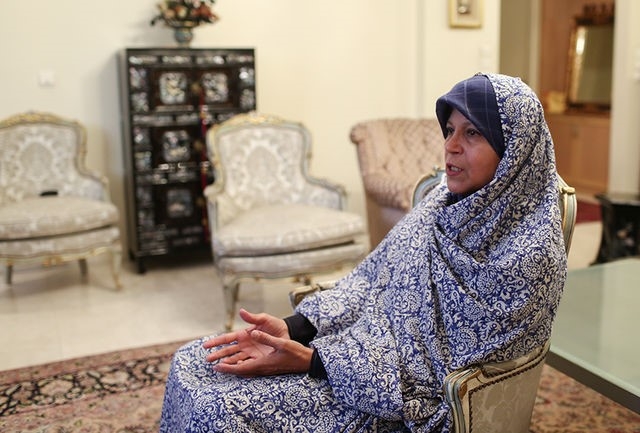Iranian press review: Late president's daughter rejects compulsory hijab

Hashemi rejects hijab law
Faezeh Hashemi, a former legislator and daughter of a former president of the Islamic Republic, voiced her rejection to the state's policy of forcing hijab on women in an interview with the Borna news agency.
“The more pressure is exerted to impose hijab, the more opposition to religion there is and the more hijab is avoided [in Iranian society],” Hashemi said.
Hashemi, who wears a chador, added that “many religious leaders” are against enforcing hijab.
Pointing to other examples of ineffective state policies aimed at forcefully changing social attitudes, Hashemi said that although satellite dishes are illegal in Iran, they are widely used by citizens. “When a law is not legitimate anymore, it loses its impact,” she said.
New MEE newsletter: Jerusalem Dispatch
Sign up to get the latest insights and analysis on Israel-Palestine, alongside Turkey Unpacked and other MEE newsletters
Hashemi is the youngest daughter of Akbar Hashemi Rafsanjani, president from 1989 to 1997 and a close aide to Ayatollah Rouhollah Khomeini. Faezeh Hashemi has been a controversial political figure since she entered the world of politics as a lawmaker in 1996.
With the emergence of reformists into power in 1997, Hashemi published Zan, a daily with a focus on women’s rights. However, the paper was banned by hardliners seven months later.
During the 2009 uprising, Hashemi participated in anti-government demonstrations and served two separate six-month sentences based on convictions for “propaganda against the system”.
Nearly three-quarters of workers in poverty
The number of Iranian workers below the poverty line has been on the rise since May 2018, and has now reached 70 percent of all workers, the Hamdeli daily reported.
On 1 May, International Workers’ Day, the paper wrote that Iranian labourers' three main challenges are a lack of job security, low wages and a state ban on establishing independent syndicates.
On the same day, Meidaan electronic daily analysed the results of studies at the University of Groningen, which show that compensation for the public sector's employees has nearly halved as a share of GDP from 40 percent to 25 over the last two decades in Iran.
Meanwhile, unverified reports on social media said that about 30 labour rights activists were arrested during a May Day sit-in in front of the Iranian parliament.
Since 1998, labour activism in Iran has been common, and several trade unionists such as Reza Shahabi, Esmail Abdi and Mansour Osanlou have received long prison sentences for their struggle to guarantee Iranian workers basic rights.
US sanctions emptying bookshelves
US sanctions had a heavy toll on the 32nd Tehran International Book Fair, which opened its doors on 24 April as many publication houses struggle to buy paper to print new books, the Hamshahri daily reported.
Under the headline “The Cold Spring of the Book”, Hamshahri examined Iran’s troubled publishing industry at a time when prices of books have tripled since the US reimposition of sanctions on Iran.
“It seems that high prices have scared off the audience,” the paper reported from the book fair.
“Visitors come and wander, but not many of them think of buying books. There is no sign of advertisements for books, nor any signs of large crowds in front of the stalls of publication houses.”
Iranian book lovers have also expressed on social media their regret for being unable to buy new books.
“I went to the book fair, and only touched the book covers of those I wanted to buy, then left them with a look full of regret. How badly I wish I could buy them, I could kiss them,” an Iranian named Rahil wrote on Twitter.
Foreign tourists flock to cheap Iran
Data published by the Iranian officials show that the number of Iranians going on vacation to other countries declined in 2018, while the number of visiting tourists went up.
The head of tourism office at Iran’s Cultural Heritage, Handcraft and Tourism Organisation, Vali Teimouri, said that tourists visiting Iran increased by 52.5 percent, reaching about 7.8m visitors during the last Persian year (between March 2017 and March 2018).
According to Teimouri, most travellers to Iran were from neighbouring countries, adding that “even tourists from European and American countries” also visited the country.
Since the US withdrawal from the nuclear deal with Iran in May 2018, the Islamic Republic has been experiencing one of its worst financial crisis. The devaluation of the Iranian rial against foreign currencies, however, has worked in the tourism sector's favour, making the country a cheap destination for visitors from Iraq, Pakistan and Lebanon.
Meanwhile, the number of Iranians travelling abroad for vacations has fallen from over 10m to less than 7m in the same period, CHTN reported.
Other than economic difficulties, Iranians’ choice for travelling abroad is extremely narrowed by the strict visa policies imposed by western countries for Iranian citizens. Most foreign embassies in Iran rarely issue tourist visas for regular citizens.
Middle East Eye delivers independent and unrivalled coverage and analysis of the Middle East, North Africa and beyond. To learn more about republishing this content and the associated fees, please fill out this form. More about MEE can be found here.




